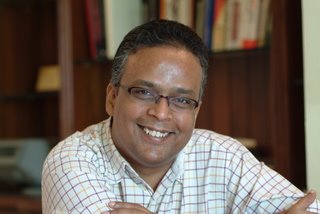I have spent the last 2 and a half days at the India Today Conclave in
So in my own small way, I shall now fill the breach and tell the two and a half people who read my blog, all about the conclave. Or at least, the bits that impressed me the most.
Space tourism is here. We got to see a model of the plane that will launch the space vehicle, a model of the space vehicle, a video of the first test flight and an animation video of what it will be like when the space vehicle goes up with passengers. All this was presented to us by Stephen Attenborough, commercial director, Virgin Galactic. The most amazing bits about the space travel are the two breakthrough innovations that are going to make space travel cheaper and safer at the same time. One is the idea of launching the "rocket" from the air rather than the ground. It requires less energy and is safer because if something goes wrong, the rocket can simply glide down to earth. The second idea is to have rotating wings that turn to slow down the vehicle's re-entry into the atmosphere and ensures that it is not as stressful an event as it has been for the space shuttles. Difficult to explain in a few words, but you might like to go to Virgin Galactic's site and watch the flash videos about the technology.
Sunil Mittal and Wim Elfrink, Chief Global Officer of Cisco, made excellent presentations on the future of communications. Not just about what technology is going to do, but how it will affect human beings. Sunil spoke about empowerment of people the mobile phone will be the identity card and the credit card for the poor. He also made a fervent appeal to not have any more regulators for his industry. Mr. Elfrink showed us the benefits of "Tele-presence" and how that would change the way we live and work.
Now that I have revealed my fascination for technology by opening this piece with the most techy bits, let me move on to the other people were fascinating.
 Narendra Modi, Vikram Akula, Yasin Malik and Peter Roebuck were the speakers who made the biggest impression on me. That is saying something since the other speakers included Bill Clinton, Al Gore, L K Advani, Chidambaram, Mukesh Ambani, Adam Gilchrist, Amir Khan, Preity Zinta, Sachin Pilot, Farookh Abdullah, Digvijay Singh, Bishen Bedi, Ashok Amritraj and Craig Venter.
Narendra Modi, Vikram Akula, Yasin Malik and Peter Roebuck were the speakers who made the biggest impression on me. That is saying something since the other speakers included Bill Clinton, Al Gore, L K Advani, Chidambaram, Mukesh Ambani, Adam Gilchrist, Amir Khan, Preity Zinta, Sachin Pilot, Farookh Abdullah, Digvijay Singh, Bishen Bedi, Ashok Amritraj and Craig Venter.
I must also mention in this context that some of the moderators were brilliant too. Aron Purie, Anand Mahindra, Shekhar Kapur and Prabhu Chawla excelled in this role. I have never seen such high quality moderation at any panel discussion before.
Narendra Modi & Yasin Malik (the Kashmir Liberation Front leader who is fighting for an independent
I didn't dare do a similar exercise after Yasin Malik's speech. I did put my foot in my mouth by saying that I was impressed by him to a person who, I later discovered, was a Kashmiri Pandit. This gentleman was already seething and he just let me have it. He called Malik a murderer, a rapist and a terrorist and criticized the India Today people for having him at the conclave. He was not alone. A few people were demonstrating outside the hotel and one person actually entered the hall and shouted to have the event stopped. He was escorted out by the security people.
Mr. Al Gore’s speech was billed as the highlight of the conclave. The turnout for this absolutely amazing. Half the Indian cabinet (including Mr. Chidambaram) were present. All the speakers stayed on to listen to him – this included film stars like Preity Zinta and Amir Khan. All the industrialists came back from their meetings. (I even noticed Mr. & Mrs Adi Godrej, who seemed to have flown in from
In the end, the speech was a little disappointing. I guess it is tough to live up to such hype. Especially when you have just one theme to talk about and everyone has seen the movie where you said it all. Still, he did very well in the Q&A. I noticed that Mr. Aroon Purie only allowed the high and mighty to ask questions of Mr. Gore.
The conclave was exceptional in the wide range of topics that it covered. The theme was “Leadership in the 21st century”. Sessions were ear marked to study leadership issues in communication, ethics, spirituality, sports, entertainment, the environment etc. There was even a youth forum where speakers spoke on what they would do if they could change the world. This is where Vikram Akula, who is
Its tiring sitting in those uncomfortable chairs all day for two and a half days. One eats a lot and doesn’t exercise at all. But in this conference, the mind got good food and good exercise. Thank you India Today for that.
